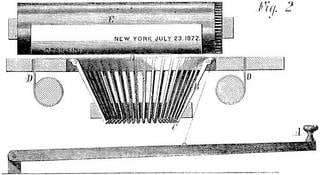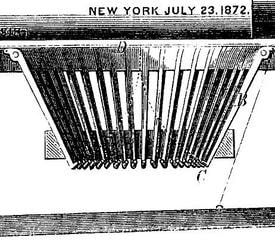いまどこ ―冒頭表示2
キーボードの2段めと3段目はなぜ互い違いになっていないの - 教えて!goo:
に答えてってな形で部分統合しようかナとも思う。
http://blog.goo.ne.jp/raycy/e/c11db5b33d4a1d67900e568ab0dc6273ではちょっとスレ違うと思う。
http://www6.atpages.jp/~raycy/Q/ を http://www6.atpages.jp/raycy/blog2btron/door やらの作業経過を取り入れつつ、ふくらませるようなかんじで、、
http://www6.atpages.jp/~raycy/Q/ を http://www6.atpages.jp/raycy/blog2btron/door やらの作業経過を取り入れつつ、ふくらませるようなかんじで、、
http://www.google.com/patents?q=sholes+alignment&btnG=Search+Patents
sholes alignment - Google Patents
http://books.google.com/books?q=sholes+alignment&btnG=Search+Books
sholes alignment - Google Book Search
sholes alignment - Google Patents
http://books.google.com/books?q=sholes+alignment&btnG=Search+Books
sholes alignment - Google Book Search
http://www.google.com/patents?id=DVZEAAAAEBAJ&dq=596371
TYPE-WRITING MACHINE - Google Patents
Patent number: 596371 ←Q謎『キーボード配列 QWERTYの謎』★30
Filing date: Jun 23, 1879
Issue date: Dec 28, 1897
Inventor: WILLIAM K. JENNE
Assignee: THE WTCKOPF

---------------------------
この図は、ショールズ‐Schwalbach系の図に近いものがあるなあ、、
ではあるが、結節駆動力伝達機構での、駆動力伝達メディアはワイヤーからリンク駆動に代わったのかな?ロット棒へと?
TYPE-WRITING MACHINE - Google Patents
Patent number: 596371 ←Q謎『キーボード配列 QWERTYの謎』★30
Filing date: Jun 23, 1879
Issue date: Dec 28, 1897
Inventor: WILLIAM K. JENNE
Assignee: THE WTCKOPF
---------------------------
この図は、ショールズ‐Schwalbach系の図に近いものがあるなあ、、
ではあるが、結節駆動力伝達機構での、駆動力伝達メディアはワイヤーからリンク駆動に代わったのかな?ロット棒へと?
http://slashdot.jp/~yasuoka/journal/400631ちょっと図がよく描けてるよなあ、myもしや機構説明にalignmentアラインメント問題解決の秘策秘訣代替手段 ←が書かれてるかも?と思って、
1871年10月29日付のタイプライター特許 - yasuoka の日記
PM 04:31 - 1871年10月29日付のタイプライター特許
1872年8月10日付Scientific Americanの表紙記事『The Type Writer』を読み返していて、妙な記述に気がついた。
Figure.1 SHOLES' TYPE WRITER
http://kanji.zinbun.kyoto-u.ac.jp/~yasuoka/QWERTY/1872-08-10.djvu
THE TYPE WRITER
―――――
In the month of July, 1867, we published an article describing a type writing machine, invented by a Mr.Pratt, of Alabama, which had then just been placed on exhibition in England. ・・・.
The difficulty which everyone, heretofore attempting to construct apparatus of this nature, has encountered has been so to govern the types making the impressions on the sheet that the characters should follow each other in even lines and at proper intervals, in the same manner as the letters on a printed page. The ingenious manner in which this problem has been solved is shown in Fig.2, which is a sectional view comprising the sddential portion of the device. "A" is a lever or key from which a wire leads to the short arm of one of the type levers,"B". These type levers, at the lower ends of which, "C", the types are attached, are arranged in a circle, a section of which is shown in the engraving, so that when they are at rest they form a sort of pot, shaped like the frustum of a cone. "D" is an inked ribbon passing over rollers and extending between the paper rolled on the cylinder,E, and the type. A pressure on the knob of the lever,"A",pulls down the wire, which, drawing down the short arm of one of the type levers, causes the end of the corresponding long arm to rise up and strike against the ribbon, thus leaving the impression of the type on the paper, As these levers are arranged in a circle, and their long arms made equal to the radius of the same, in is evident that the type ends of all will strike exactly at the center, so that if a piece of paper be immovably eld directly over that point, the entire alphabet, punctuation marks,etc., may be printed one letter over another on precisely the same spot.
OCN翻訳サービス|
タイプ作家
―――――
1867年7月の月に、私達は、その時のちょうどイギリスの展示会に置かれたアラバマのタイプ書き込みマシン〈プラットさんにより発明された〉を説明している記事を出版しました。 ・・・.
文字が均一なラインにおいて、および適切な間隔によってお互いに続いているはずであるというシートへの感じを与えるタイプを制御することも、誰〈従来 この自然の装置を組み立てる試行 の〉もが遭遇した困難がそうでした、プリントされたページの手紙と同じ方法において。 この問題が解決された巧妙な方法は、図2において示されます。それは、機器のsddentialな部分から成っている断面図です。 「A」は、レバーまたはワイヤがタイプレバー、「B」のうちの1つの短いアームをもたらしているキーです。 下端 of which のこれらのタイプレバー、「C」、タイプは付属しています、円、彫版において示されるセクションで手配します、それらが静止してある時に、それらが一種のポットを成形するように 円錐の切頭体のように形づくられる 。 「D」は、シリンダに転がされた紙とEとタイプの間でローラーと拡張を見落としているインクをつけられたリボンです。 レバー、「A」、引くこと ワイヤ whichタイプレバーのうちの1つの短いアームに沿った図面 の下の, のノブのプレッシャーは、対応した長い間の終わりを起こし スト リボン 、武装します 上がるおよび 、従って、タイプの紙への効果を残します、円において
これらのレバーが配置されて、それらの長い腕が同じの半径と等しくした すべてのタイプ終わりがセンターを正確に打つので、中が明らかであると、従って 紙の断片が確固としてそのポイントのすぐ上の老年である 、全体のアルファベット、句読点などはプリントできます 正確に同じ 場所 onの別のものの上の1通の手紙 。
1872年7月23日の タイプ ライター、ショート・アーム ロング・アーム
ってな感じ?
部品”B”(type lever)のピンクに着色した部分を支点として、支点からワイヤー差込点までがショート・アーム、支点から”C”印字タイプの取り付けられた部分までがロング・アーム。
このショートかつロング・アーム部は一体成型で、ねずみ鋳鉄gray [grey] cast iron (P.61)←製か?
attached とあるのは、活字部”C”は差込かなんかで取替え可能な構造なのかな?どうなんだろう?
もし一体成型でなければ、「点対称文字易移動性仮説」 ← ← ←は崩れるかも、、でも□四角い差込口とかでも、削って調整ってことはあるかも?
アラインメントの解決の秘策まではかかれてないような、
過去のタイプ・ライターへのチャレンジャーの課題には 一定の文字送りとアラインメントにあったとは書かれてあるような、ではあるが、、
----------------------------------
Q謎『キーボード配列QWERTYの謎』の著者のお一人でもある、本冒頭の引用
記事『The Type Writer』を読み返しておられる著者が、目を通していない ←とはいえまいが、ここに現れるshort arm 、long arm については、目を通した結果、どう判断されたのであろうか?
あるいは読み返したが、特段の着目をされなかったのであろうか?
アームの出現、
ドーアティー[★72] ←(P.119)とされてあるし。
























